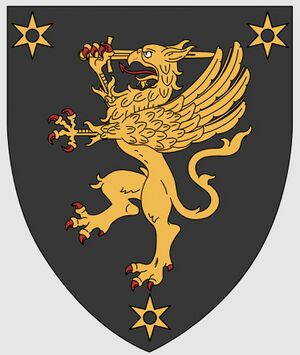Union of Sarpedonian States: Difference between revisions
m (→History) Tag: 2017 source edit |
mNo edit summary Tag: 2017 source edit |
||
| Line 141: | Line 141: | ||
The '''Union of Sarpedonian States''' ({{lang-es|Unión de Estados de Sarpedon}}, {{lang-cd|União dos Estados de Sarpedon}}), often stylized and abbreviated '''UNESARP''', is a Sarpedonian political and economic union established by the [[Vila Real Accord]] in 2026. Its full members are [[Cartadania]] and [[Pelaxia]]. Passport controls have been abolished for travel between the countries and a monetary union established in 2026, will go into full force in during 2028 | The '''Union of Sarpedonian States''' ({{lang-es|Unión de Estados de Sarpedon}}, {{lang-cd|União dos Estados de Sarpedon}}), often stylized and abbreviated '''UNESARP''', is a Sarpedonian political and economic union established by the [[Vila Real Accord]] in 2026. Its full members are [[Cartadania]] and [[Pelaxia]]. Passport controls have been abolished for travel between the countries and a monetary union established in 2026, will go into full force in during 2028 | ||
== History == | == History == | ||
The Union of Sarpedonian States (UNESARP), a political and economic alliance between Cartadania and Pelaxia, finds its roots in the historical tapestry woven by years of shared geopolitical interests and a burgeoning Pansarpedonian sentiment. The journey toward this union commenced with the Vila Real Accords, a pivotal agreement signed in 2026, marking the initial steps of the Pansarpedonian movement. | The Union of Sarpedonian States (UNESARP), a political and economic alliance between Cartadania and Pelaxia, finds its roots in the historical tapestry woven by years of shared geopolitical interests and a burgeoning Pansarpedonian sentiment. The journey toward this union commenced with the Vila Real Accords, a pivotal agreement signed in 2026, marking the initial steps of the Pansarpedonian movement. | ||
Carto-Pelaxia Commonwealth and Shared History: The foundation of the [[Carto-Pelaxian Commonwealth]] during the First Great War laid the groundwork for the intricate relations between Cartadania and Pelaxia. As the alliance weathered the storms of the Second Great War, the nations found themselves frequently aligned, not just in military endeavors but also in political and economic pursuits. The Commonwealth became a testament to the strength forged in shared challenges. | Carto-Pelaxia Commonwealth and Shared History: The foundation of the [[Carto-Pelaxian Commonwealth]] during the First Great War laid the groundwork for the intricate relations between Cartadania and Pelaxia. As the alliance weathered the storms of the Second Great War, the nations found themselves frequently aligned, not just in military endeavors but also in political and economic pursuits. The Commonwealth became a testament to the strength forged in shared challenges. | ||
| Line 173: | Line 172: | ||
== Economy == | == Economy == | ||
== Structure == | == Structure == | ||
[[File:Vila Real Accords.png|alt=First page of the Vila Real Accords. Copy from the Pelaxian Nationa Archive.|thumb]] | |||
=== DEFESARP === | === DEFESARP === | ||
[[File:Pelaxian and cartadanian soldiers.jpeg|thumb|Cartadanian soldiers laying down next to a Pelaxian M113 PLX at "Complejo de los Ballesteros"]] | [[File:Pelaxian and cartadanian soldiers.jpeg|thumb|Cartadanian soldiers laying down next to a Pelaxian M113 PLX at "Complejo de los Ballesteros"]] | ||
Revision as of 22:38, 9 December 2023
This article is a work-in-progress because it is incomplete and pending further input from an author. Note: The contents of this article are not considered canonical and may be inaccurate. Please comment on this article's talk page to share your input, comments and questions. |
Union of Sarpedonian States
| |||||
|---|---|---|---|---|---|
|
Flag | |||||
| Globe projection with the UNESARP in green Dark green: full members. Light green: associated members. Blue: observer members. | |||||
| Institutional seats |
| ||||
| Largest metropolis | Greater Palm Coast | ||||
| Official languages | Three languages | ||||
| Official script | Latin | ||||
| Demonym(s) | Sarpedonian | ||||
| Type | Supranational union | ||||
| Membership | 2 members | ||||
| Government | Intergovernmental | ||||
| Macos Reyes | |||||
| Leyre Castrillón | |||||
| Arsenio Freitas | |||||
| Cartadania | |||||
| Formation | |||||
| 2026 | |||||
| Area | |||||
• Total | 5,650,240 km2 (2,181,570 sq mi) | ||||
| Population | |||||
• 2025 estimate | 592,989,817 | ||||
• Density | 104.9/km2 (271.7/sq mi) | ||||
| GDP (PPP) | 2026 estimate | ||||
• Total | |||||
• Per capita | |||||
| GDP (nominal) | 2026 estimate | ||||
• Total | |||||
• Per capita | |||||
| Gini (2026) | medium | ||||
| HDI (2026) | very high | ||||
| Currency | Real (₹) (SAR) | ||||
| Time zone | UTC-2 to UTC-5, UTC-9 to UTC-10 | ||||
| Internet TLD | .sar | ||||
Website unesarp | |||||
The Union of Sarpedonian States (Spanish: Unión de Estados de Sarpedon, Cartadanian: União dos Estados de Sarpedon), often stylized and abbreviated UNESARP, is a Sarpedonian political and economic union established by the Vila Real Accord in 2026. Its full members are Cartadania and Pelaxia. Passport controls have been abolished for travel between the countries and a monetary union established in 2026, will go into full force in during 2028
History
The Union of Sarpedonian States (UNESARP), a political and economic alliance between Cartadania and Pelaxia, finds its roots in the historical tapestry woven by years of shared geopolitical interests and a burgeoning Pansarpedonian sentiment. The journey toward this union commenced with the Vila Real Accords, a pivotal agreement signed in 2026, marking the initial steps of the Pansarpedonian movement. Carto-Pelaxia Commonwealth and Shared History: The foundation of the Carto-Pelaxian Commonwealth during the First Great War laid the groundwork for the intricate relations between Cartadania and Pelaxia. As the alliance weathered the storms of the Second Great War, the nations found themselves frequently aligned, not just in military endeavors but also in political and economic pursuits. The Commonwealth became a testament to the strength forged in shared challenges.
As the world transitioned into the 21st century, a resurgence of Pansarpedonian movements gained momentum. The increasing interconnectivity and global challenges necessitated collaborative efforts. Cartadania and Pelaxia, acknowledging their historical ties, began exploring avenues to fortify their partnership in the face of evolving geopolitical dynamics.
Vila Real Accords, a milestone in unity, signed in 2036, stand as a cornerstone in the formation of UNESARP. Crafted with the intention of fostering collaboration, these accords echoed the commitment of both nations to principles such as sovereign equality, good neighborliness, and non-interference. Recognizing the democratic and outward-looking nature of each other, Cartadania and Pelaxia laid the groundwork for deeper ties. Against the backdrop of a resurgent Pansarpedonian sentiment, the Vila Real Accords acted as a catalyst. The movement aimed to bridge historical divisions and create a united front against new global challenges, particularly those posed by international terrorism and transnational crime. The common regional interests and ties between Cartadania and Pelaxia took center stage.
With the Vila Real Accords setting the stage, the Union of Sarpedonian States emerged as a formal alliance in 2-26. The abolishment of passport controls and the establishment of a monetary union signaled a deeper integration. As both nations moved toward greater collaboration in various domains, the Union became a symbol of regional stability, progress, and prosperity. With passport controls have been abolished for travel between the countriea, a monetary union established in 2026 would go into full force in during 2028.
Key figures instrumental in this historical journey included Prime Minister of Pelaxia Pedro Meireles, Marcos Reyes, Leyre Castrillón, and President of Cartadania Anteros Ballas. Their commitment to the ideals embedded in the Vila Real Accords paved the way for the establishment of UNESARP. In conclusion, the Union of Sarpedonian States is not just a contemporary alliance; it is the culmination of a shared history, a response to emerging global challenges, and the embodiment of the Pansarpedonian movement that sought to unite nations for a common future.
Geography
Member states
Observer states
Burgundie considers itself an observer of UNESARP, while it is not eligible to be a member both from the perspective of the Sarpedonian states as well as its commitments to the Levantine Union, it considers Cartadania and Pelaxia core allies and would protect either of them if their Sarepdonian territories were infringed upon. Burgundie also conducts economic and diplomatic interactions with both nations in accordance with the framework of UNESARP. Bound by their shared Romance culture and ARGUS apparatus (with (Cartadania), Burgundie also follows (where it doesnt contradict its commitments to the Levantine Union) the cultural and educational elements of UNESARP.
Demographics
Population
Urbanisation
Languages
Religion
Politics
Institutions
Legal system
Foreign relations
Observers
The Cape
Vallejar
Ceylonia
Economy
Structure

DEFESARP


The central principle holding DEFESARP is that an attack against one is to be considered an attack against both; this was known as the "Cognati defense" doctrine, and as a logical continuation of the Vila Real Accords. The pact also includes cooperation on military training, advanced cyber, artificial intelligence and autonomy, quantum technologies, undersea capabilities, hypersonic and counter-hypersonic, electronic warfare, innovation and information sharing.
Under the pact Cartadania and Pelaxia have mutual access to joint naval bases in Maribel Island, Las Jusonias, Freda Island, Lotoa and Solemia, extending the reach of the alliance further away than just the Tainean and Kindred Sea. They also mantain a Joint Aerospace Traning center in Cartadania and the largest Joint Military Training Camp at "Complejo de los Ballesteros" in Pelaxia.
DEFESARP has obliged both militaries to integrate their early warning, awarnes and command structure under the DEFESARP Air Defence Command (ADC) and the Kindred and Tainean Sea Joint Naval Command (KTS-Joint Naval Command). DEFESARP holds yearly military command exercises for Pelaxia and Cartadania to have an opportunity to improve inter-organization cooperation, and has under its mandate created the Cognati Corps.
Cognati Corps
The Cognati Corps (Spanish: Cuerpo de Coñata; Cartadanian: Corpo da Conhata) is a binational combined arms coprs consisting of units from the Cartadanian and Pelaxian militaries.The Corps a high-readiness force comprising land, air, sea and special forces units capable of being deployed quickly.
Rotating forces through the Cognati Corps requires both nations to meet the demanding standards needed for collective defence and expeditionary operations. As the standards are very high, participation in the Corps is preceded by a six-month DEFESARP exercise program in order to integrate and standardize the various contingents. Generally, units carry out a pre-training period in preparation for the DEFESARP exercises of between 6–18 months. Once activated, Reconnaissance Teams deploy within 5 days. This is the first of a number of deployment phases that lead to the deployment of the entire HQ Joint Task Force and CorpsForces within 30 days.
The Corps currently comprises up to 60,000 troops and will be increased to over 100,000 troops. It includes units from several overseas territories.
The Cognati Corps trains for various tasks, including:
- providing immediate collective defence of UNESARP members in the event of military operation;
- crisis management;
- acting as the initial force deployment as a precursor to deployment of a much larger force;
- peace support;
- disaster relief;
- protection of critical infrastructure.